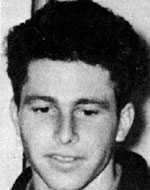Ronkin, Emanuel
Son of Yitzhak and Bluma (Odes). He was born on 21 July 1941 in Kibbutz Kfar Masaryk. He completed his elementary and high school studies in his kibbutz. At a young age, he showed talent for painting and his parents sent him to the painter Marcel Janco to study the art of drawing in the “Arnim” seminar. He also learned from the painter Zvi Meirovich the art of oil painting. He participated in young exhibitions and was awarded the Histadrut Prize, and was awarded an honorary prize by the Norman Foundation in October 1960. He was drafted into the IDF in October 1960 and assigned to the Armored Corps. After completing his regular service, he returned to the kibbutz himself and worked in the orchards. His father writes about him as follows: “He loved life and was joyful every time he managed to” create “a picture that appealed to him but also contained deep pessimism and a certain skepticism about the fate of Adam and especially the fate of a young Jew in this country and in this world. He looked for the spirit of the East, the spirit of the land of the past, the imagination of the silversmith, the work of silver and gold, embroidery of light and shade. His father continues to say that before his approach to the painter, he used to read one of his favorite poetry books or one of the books of philosophy to “draw inspiration,” as he would say, and together with the abundance of light he poured in his cloths, . He knew as every artist-artist that good works are created only in the “Holy Spirit.” After his discharge from the army he was called up for reserve duty from time to time. In the days of tension before the Six-Day War, his father tells about him, after a joyous evening in the family circle, Emanuel was called to the flag. Before leaving for a separate road from his mother and sister. In his last letter to the family, written on the day after the first battle, he asked for his Bible to be sent to him, because he needed it, he wrote, “to maintain morale.” In that letter he expressed his strong desire: “May the war be over and this killing …” During the two days of the Battle of Kuntilla he left the city safely, and on June 7 he moved northward, fighting as a tank soldier and proving his courage and willingness to sacrifice his past in the northern border towards the Kela outpost, on the fifth day of the battles. 1967), and in that battle he fell. Was brought to rest in his village Kfar Masaryk. His estate contains over 100 oil paintings and hundreds of drawings and lithographs. His works have been published in various publications (such as Gazit, Hotam and Hadim). His works (oil paintings and drawings) were exhibited at the Tel Aviv Museum of Art, in Nissan in 1969, at the Haifa Museum and in Nissan, 1970. The Yad Labanim Museum was presented by the Committee for Independence Day celebrations in that year as one of the memorial works of The bulletin of Kibbutz Kfar Masaryk, “Hed Hadash”, appeared on the occasion of “Thirty” and the fall of Avraham Chipser, in which 53 “of them” were published by the Kibbutz Artzi in memory of its fallen comrades. Hamishmar “, an artistic album of his paintings and drawings, in the collection of the fallen sons of the fallen soldiers in Israel -” Goily Ash “, part 4 – was brought from his estate.
